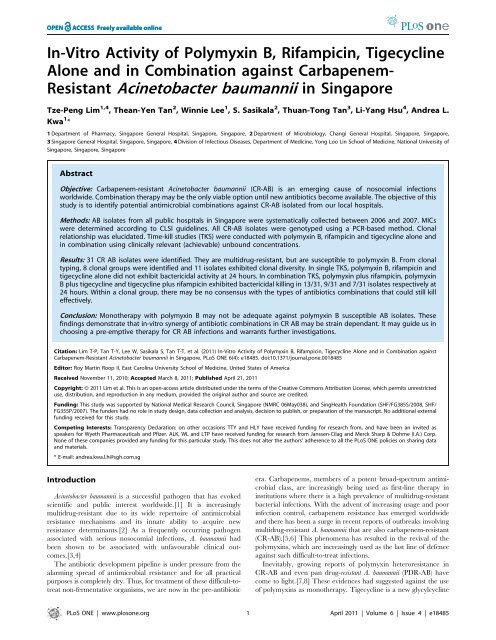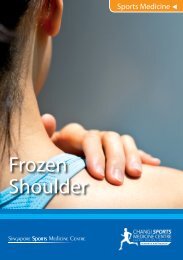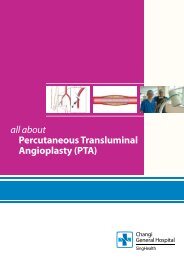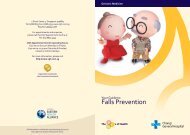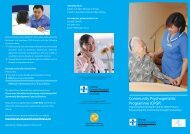Resistant Acinetobacter baumannii in Singapore - Changi General ...
Resistant Acinetobacter baumannii in Singapore - Changi General ...
Resistant Acinetobacter baumannii in Singapore - Changi General ...
Create successful ePaper yourself
Turn your PDF publications into a flip-book with our unique Google optimized e-Paper software.
In-Vitro Activity of Polymyx<strong>in</strong> B, Rifampic<strong>in</strong>, Tigecycl<strong>in</strong>e<br />
Alone and <strong>in</strong> Comb<strong>in</strong>ation aga<strong>in</strong>st Carbapenem-<br />
<strong>Resistant</strong> <strong>Ac<strong>in</strong>etobacter</strong> <strong>baumannii</strong> <strong>in</strong> S<strong>in</strong>gapore<br />
Tze-Peng Lim 1,4 , Thean-Yen Tan 2 , W<strong>in</strong>nie Lee 1 , S. Sasikala 2 , Thuan-Tong Tan 3 , Li-Yang Hsu 4 , Andrea L.<br />
Kwa 1 *<br />
1 Department of Pharmacy, S<strong>in</strong>gapore <strong>General</strong> Hospital, S<strong>in</strong>gapore, S<strong>in</strong>gapore, 2 Department of Microbiology, <strong>Changi</strong> <strong>General</strong> Hospital, S<strong>in</strong>gapore, S<strong>in</strong>gapore,<br />
3 S<strong>in</strong>gapore <strong>General</strong> Hospital, S<strong>in</strong>gapore, S<strong>in</strong>gapore, 4 Division of Infectious Diseases, Department of Medic<strong>in</strong>e, Yong Loo L<strong>in</strong> School of Medic<strong>in</strong>e, National University of<br />
S<strong>in</strong>gapore, S<strong>in</strong>gapore, S<strong>in</strong>gapore<br />
Abstract<br />
Objective: Carbapenem-resistant <strong>Ac<strong>in</strong>etobacter</strong> <strong>baumannii</strong> (CR-AB) is an emerg<strong>in</strong>g cause of nosocomial <strong>in</strong>fections<br />
worldwide. Comb<strong>in</strong>ation therapy may be the only viable option until new antibiotics become available. The objective of this<br />
study is to identify potential antimicrobial comb<strong>in</strong>ations aga<strong>in</strong>st CR-AB isolated from our local hospitals.<br />
Methods: AB isolates from all public hospitals <strong>in</strong> S<strong>in</strong>gapore were systematically collected between 2006 and 2007. MICs<br />
were determ<strong>in</strong>ed accord<strong>in</strong>g to CLSI guidel<strong>in</strong>es. All CR-AB isolates were genotyped us<strong>in</strong>g a PCR-based method. Clonal<br />
relationship was elucidated. Time-kill studies (TKS) were conducted with polymyx<strong>in</strong> B, rifampic<strong>in</strong> and tigecycl<strong>in</strong>e alone and<br />
<strong>in</strong> comb<strong>in</strong>ation us<strong>in</strong>g cl<strong>in</strong>ically relevant (achievable) unbound concentrations.<br />
Results: 31 CR AB isolates were identified. They are multidrug-resistant, but are susceptible to polymyx<strong>in</strong> B. From clonal<br />
typ<strong>in</strong>g, 8 clonal groups were identified and 11 isolates exhibited clonal diversity. In s<strong>in</strong>gle TKS, polymyx<strong>in</strong> B, rifampic<strong>in</strong> and<br />
tigecycl<strong>in</strong>e alone did not exhibit bactericidal activity at 24 hours. In comb<strong>in</strong>ation TKS, polymyx<strong>in</strong> plus rifampic<strong>in</strong>, polymyx<strong>in</strong><br />
B plus tigecycl<strong>in</strong>e and tigecycl<strong>in</strong>e plus rifampic<strong>in</strong> exhibited bactericidal kill<strong>in</strong>g <strong>in</strong> 13/31, 9/31 and 7/31 isolates respectively at<br />
24 hours. With<strong>in</strong> a clonal group, there may be no consensus with the types of antibiotics comb<strong>in</strong>ations that could still kill<br />
effectively.<br />
Conclusion: Monotherapy with polymyx<strong>in</strong> B may not be adequate aga<strong>in</strong>st polymyx<strong>in</strong> B susceptible AB isolates. These<br />
f<strong>in</strong>d<strong>in</strong>gs demonstrate that <strong>in</strong>-vitro synergy of antibiotic comb<strong>in</strong>ations <strong>in</strong> CR AB may be stra<strong>in</strong> dependant. It may guide us <strong>in</strong><br />
choos<strong>in</strong>g a pre-emptive therapy for CR AB <strong>in</strong>fections and warrants further <strong>in</strong>vestigations.<br />
Citation: Lim T-P, Tan T-Y, Lee W, Sasikala S, Tan T-T, et al. (2011) In-Vitro Activity of Polymyx<strong>in</strong> B, Rifampic<strong>in</strong>, Tigecycl<strong>in</strong>e Alone and <strong>in</strong> Comb<strong>in</strong>ation aga<strong>in</strong>st<br />
Carbapenem-<strong>Resistant</strong> <strong>Ac<strong>in</strong>etobacter</strong> <strong>baumannii</strong> <strong>in</strong> S<strong>in</strong>gapore. PLoS ONE 6(4): e18485. doi:10.1371/journal.pone.0018485<br />
Editor: Roy Mart<strong>in</strong> Roop II, East Carol<strong>in</strong>a University School of Medic<strong>in</strong>e, United States of America<br />
Received November 11, 2010; Accepted March 8, 2011; Published April 21, 2011<br />
Copyright: ß 2011 Lim et al. This is an open-access article distributed under the terms of the Creative Commons Attribution License, which permits unrestricted<br />
use, distribution, and reproduction <strong>in</strong> any medium, provided the orig<strong>in</strong>al author and source are credited.<br />
Fund<strong>in</strong>g: This study was supported by National Medical Research Council, S<strong>in</strong>gapore (NMRC 06May038), and S<strong>in</strong>gHealth Foundation (SHF/FG385S/2008, SHF/<br />
FG355P/2007). The funders had no role <strong>in</strong> study design, data collection and analysis, decision to publish, or preparation of the manuscript. No additional external<br />
fund<strong>in</strong>g received for this study.<br />
Compet<strong>in</strong>g Interests: Transparency Declaration: on other occasions TTY and HLY have received fund<strong>in</strong>g for research from, and have been an <strong>in</strong>vited as<br />
speakers for Wyeth Pharmaceuticals and Pfizer. ALK, WL and LTP have received fund<strong>in</strong>g for research from Janssen-Cilag and Merck Sharp & Dohme (I.A.) Corp.<br />
None of these companies provided any fund<strong>in</strong>g for this particular study. This does not alter the authors’ adherence to all the PLoS ONE policies on shar<strong>in</strong>g data<br />
and materials.<br />
* E-mail: andrea.kwa.l.h@sgh.com.sg<br />
Introduction<br />
<strong>Ac<strong>in</strong>etobacter</strong> <strong>baumannii</strong> is a successful pathogen that has evoked<br />
scientific and public <strong>in</strong>terest worldwide.[1] It is <strong>in</strong>creas<strong>in</strong>gly<br />
multidrug-resistant due to its wide repertoire of antimicrobial<br />
resistance mechanisms and its <strong>in</strong>nate ability to acquire new<br />
resistance determ<strong>in</strong>ants.[2] As a frequently occurr<strong>in</strong>g pathogen<br />
associated with serious nosocomial <strong>in</strong>fections, A. <strong>baumannii</strong> had<br />
been shown to be associated with unfavourable cl<strong>in</strong>ical outcomes.[3,4]<br />
The antibiotic development pipel<strong>in</strong>e is under pressure from the<br />
alarm<strong>in</strong>g spread of antimicrobial resistance and for all practical<br />
purposes is completely dry. Thus, for treatment of these difficult-totreat<br />
non-fermentative organisms, we are now <strong>in</strong> the pre-antibiotic<br />
era. Carbapenems, members of a potent broad-spectrum antimicrobial<br />
class, are <strong>in</strong>creas<strong>in</strong>gly be<strong>in</strong>g used as first-l<strong>in</strong>e therapy <strong>in</strong><br />
<strong>in</strong>stitutions where there is a high prevalence of multidrug-resistant<br />
bacterial <strong>in</strong>fections. With the advent of <strong>in</strong>creas<strong>in</strong>g usage and poor<br />
<strong>in</strong>fection control, carbapenem resistance has emerged worldwide<br />
and there has been a surge <strong>in</strong> recent reports of outbreaks <strong>in</strong>volv<strong>in</strong>g<br />
multidrug-resistant A. <strong>baumannii</strong> that are also carbapenem-resistant<br />
(CR-AB).[5,6] This phenomena has resulted <strong>in</strong> the revival of the<br />
polymyx<strong>in</strong>s, which are <strong>in</strong>creas<strong>in</strong>gly used as the last l<strong>in</strong>e of defence<br />
aga<strong>in</strong>st such difficult-to-treat <strong>in</strong>fections.<br />
Inevitably, grow<strong>in</strong>g reports of polymyx<strong>in</strong> heteroresistance <strong>in</strong><br />
CR-AB and even pan drug-resistant A. <strong>baumannii</strong> (PDR-AB) have<br />
come to light.[7,8] These evidences had suggested aga<strong>in</strong>st the use<br />
of polymyx<strong>in</strong>s as monotherapy. Tigecycl<strong>in</strong>e is a new glycylcycl<strong>in</strong>e<br />
PLoS ONE | www.plosone.org 1 April 2011 | Volume 6 | Issue 4 | e18485
Comb<strong>in</strong>ation Therapy for Carbapenem-<strong>Resistant</strong> AB<br />
that showed good <strong>in</strong>-vitro activity aga<strong>in</strong>st multidrug-resistant A.<br />
<strong>baumannii</strong> isolates. However, its cl<strong>in</strong>ical utility has yet to be<br />
demonstrated alone or <strong>in</strong> comb<strong>in</strong>ation with other antibiotics.[9]<br />
Other than str<strong>in</strong>gent <strong>in</strong>fection control measures, comb<strong>in</strong>ation<br />
therapy may be our only current rema<strong>in</strong><strong>in</strong>g viable therapeutic<br />
option <strong>in</strong> treat<strong>in</strong>g <strong>in</strong>fections caused by such bacteria. Therefore,<br />
the objective of this study was to identify potential bactericidal<br />
antimicrobial comb<strong>in</strong>ations aga<strong>in</strong>st CR-AB <strong>in</strong> S<strong>in</strong>gapore.<br />
Materials and Methods<br />
Antimicrobial agents<br />
Polymyx<strong>in</strong> B and rifampic<strong>in</strong> were obta<strong>in</strong>ed from Sigma-Aldrich<br />
(St. Louis, MO). Tigecycl<strong>in</strong>e was obta<strong>in</strong>ed from Wyeth Pharmaceuticals<br />
(Pearl River, NY). For polymyx<strong>in</strong> B, a stock solution <strong>in</strong><br />
sterile water was prepared, aliquoted, and stored at 270uC.<br />
Tigecycl<strong>in</strong>e <strong>in</strong> solution was freshly prepared before each experiment.<br />
On the other hand, rifampic<strong>in</strong> was dissolved <strong>in</strong> dimethyl<br />
sulfoxide and was then serially diluted <strong>in</strong> sterile water to the<br />
desired f<strong>in</strong>al drug concentration. The f<strong>in</strong>al dimethyl sulfoxide<br />
concentration had no effect on A. <strong>baumannii</strong> growth. Prior to each<br />
susceptibility test, an aliquot of the drug was thawed and diluted to<br />
the desired concentrations with Ca-MHB.<br />
Microorganisms and susceptibility test<strong>in</strong>g<br />
<strong>Ac<strong>in</strong>etobacter</strong> <strong>baumannii</strong> isolates from the ur<strong>in</strong>ary tract, blood and<br />
respiratory tract were collected from five geographically separate<br />
hospitals over a two-year period (2006–2007) by Network for<br />
Antimicrobial Resistance Surveillance (S<strong>in</strong>gapore). These CR-AB<br />
isolates were previously described harbour<strong>in</strong>g the blaOXA-23-like<br />
and blaOXA-51-like carbapenemase genes, with the ISAba1<br />
upstream of the blaOXA-23 gene (results not shown).[10] Genus<br />
identity was <strong>in</strong>itially determ<strong>in</strong>ed us<strong>in</strong>g conventional biochemical<br />
methods and ID-GN cards (Vitek 2, bioMérieux, France) and<br />
confirmed by PCR-based method.[11] M<strong>in</strong>imum <strong>in</strong>hibitory<br />
concentrations (MIC) to ampicill<strong>in</strong>/sulbactam, ciprofloxac<strong>in</strong>,<br />
gentamic<strong>in</strong>, imipenem, meropenem, aztreonam, piperacill<strong>in</strong>/<br />
tazobactam, polymyx<strong>in</strong> B, tigecycl<strong>in</strong>e, ceftazidime, amikac<strong>in</strong> and<br />
cefepime were obta<strong>in</strong>ed by microbroth dilution. MICs to<br />
rifampic<strong>in</strong> were obta<strong>in</strong>ed by a modified broth macrodilution<br />
method as described by the CLSI.[12] CR-AB were def<strong>in</strong>ed as<br />
isolates resistant to all tested antibiotics classes except polymyx<strong>in</strong>s.[13]<br />
The bacteria were stored at 270uC <strong>in</strong> ProtectH (Key<br />
Scientific Products, Stamford, TX, USA) storage vials. Fresh<br />
isolates were sub-cultured twice on 5% blood agar plates<br />
(Biomedia-Bloxwich, Malaysia) for 24 h at 35uC prior to each<br />
experiment.<br />
Clonal Relationship Analysis<br />
All study isolates were genotyped us<strong>in</strong>g a PCR-based method.[14]<br />
Digital images of the DNA f<strong>in</strong>gerpr<strong>in</strong>ts were processed<br />
us<strong>in</strong>g Gene Profiler 4.05 (Scanalytics, BD Biosciences, USA) and<br />
similarity analysis, distance estimation and cluster analysis us<strong>in</strong>g<br />
UPGMA were performed us<strong>in</strong>g Treecon software.<br />
Time-kill studies<br />
Time-kill studies were conducted with polymyx<strong>in</strong> B, rifampic<strong>in</strong><br />
and tigecycl<strong>in</strong>e alone and <strong>in</strong> comb<strong>in</strong>ation us<strong>in</strong>g cl<strong>in</strong>ically relevant<br />
(achievable) unbound concentrations. Hence, the simulated<br />
steady-state drug concentrations were 2 mg/L (free or unbound<br />
prote<strong>in</strong> fraction) for polymyx<strong>in</strong> B, rifampic<strong>in</strong> and tigecycl<strong>in</strong>e, with<br />
correspond<strong>in</strong>g maximum <strong>in</strong>travenous doses of at least 1 million<br />
units of polymyx<strong>in</strong> B (every 12 hours), 600 mg of rifampic<strong>in</strong> (every<br />
12 hours) and 100 mg of tigecyl<strong>in</strong>e (every 12 hours).[15,16,17]<br />
An overnight culture of the isolate was diluted <strong>in</strong>to pre-warmed<br />
cation-adjusted Mueller H<strong>in</strong>ton II broth (Ca-MHB) (BBL, BD,<br />
USA) and <strong>in</strong>cubated further at 35uC until reach<strong>in</strong>g log-phase<br />
growth. The bacterial suspension was diluted with Ca-MHB<br />
accord<strong>in</strong>g to absorbance (at 630 nm); 15 ml of the suspension was<br />
transferred to 50-ml sterile conical flasks, each conta<strong>in</strong><strong>in</strong>g 1 ml of a<br />
drug dilution at 16 times the target concentration. The f<strong>in</strong>al<br />
concentration of the bacterial suspension <strong>in</strong> each flask was<br />
approximately 10 5 CFU/ml (rang<strong>in</strong>g from 1610 5 CFU/ml to<br />
5610 5 CFU/ml).<br />
Flasks were <strong>in</strong>cubated <strong>in</strong> a shaker water bath at 35uC. Serial<br />
samples of broth were obta<strong>in</strong>ed from each flask at 0 (basel<strong>in</strong>e), 2, 4,<br />
8, 12 and 24 hours after <strong>in</strong>cubation. Samples were obta<strong>in</strong>ed <strong>in</strong><br />
duplicate at each time-po<strong>in</strong>t. Extracted broth samples (0.5 ml)<br />
were first centrifuged at 10,000 x g for 15 m<strong>in</strong>utes and then<br />
reconstituted with sterile normal sal<strong>in</strong>e to their orig<strong>in</strong>al volumes <strong>in</strong><br />
order to m<strong>in</strong>imize drug carryover. The total bacterial count for<br />
each sample was quantified by deposit<strong>in</strong>g serial 10-fold dilutions of<br />
broth samples onto Mueller H<strong>in</strong>ton agar (MHA) plates (Biomedia,<br />
Bloxwich, Malaysia) us<strong>in</strong>g a spiral-plater (Interscience, St Nom La<br />
Breteche, France).<br />
Inoculated plates were <strong>in</strong>cubated <strong>in</strong> a humidified <strong>in</strong>cubator<br />
(35uC) for 18 to 24 h, bacterial colonies were visually counted, and<br />
the orig<strong>in</strong>al bacterial density from the orig<strong>in</strong>al sample was<br />
calculated based on the dilution factor. The lower limit of<br />
detection for the colony counts was 2 log 10 CFU/ml.<br />
Pharmacodynamic endpo<strong>in</strong>ts<br />
Bactericidal activity (primary endpo<strong>in</strong>t) was def<strong>in</strong>ed as a $3<br />
log 10 CFU/ml decrease <strong>in</strong> the colony count from the <strong>in</strong>itial<br />
<strong>in</strong>oculum at 24 hours. Synergy (secondary endpo<strong>in</strong>t) was def<strong>in</strong>ed<br />
as a $2 log 10 CFU/ml decrease <strong>in</strong> the colony count by the drug<br />
comb<strong>in</strong>ation when compared with its most active constituent and<br />
a $2 log 10 CFU/ml decrease from the <strong>in</strong>itial <strong>in</strong>oculum at<br />
24 hours while <strong>in</strong>difference was def<strong>in</strong>ed as a ,2 log 10 CFU/ml<br />
change at 24 hours by the comb<strong>in</strong>ation compared with that by the<br />
most active s<strong>in</strong>gle agent.[18]<br />
Results<br />
Susceptibility<br />
Thirty-one CR-AB isolates were identified. All isolates were<br />
resistant to meropenem, imipenem, ampicill<strong>in</strong>/sulbactam, ciprofloxac<strong>in</strong>,<br />
gentamic<strong>in</strong>, aztreonam, piperacill<strong>in</strong>/tazobactam, ceftazidime,<br />
cefepime and amikac<strong>in</strong>. (data not shown) But they were<br />
susceptible to polymyx<strong>in</strong> B (MIC range 0.5–2 mg/L). There are<br />
no CLSI susceptibility breakpo<strong>in</strong>ts for rifampic<strong>in</strong> and tigecycl<strong>in</strong>e<br />
aga<strong>in</strong>st A. <strong>baumannii</strong>. The MICs of rifampic<strong>in</strong> and tigecycl<strong>in</strong>e<br />
ranged from 1–$64 mg/L and 0.5–$32 mg/L respectively<br />
(Table 1).<br />
Clonal Relationship Analysis<br />
Apply<strong>in</strong>g a similarity <strong>in</strong>dex of 90% to PCR typ<strong>in</strong>g results, 8<br />
clonal clusters were identified consist<strong>in</strong>g of groups of 2 or 3 isolates<br />
for each cluster. Eleven rema<strong>in</strong><strong>in</strong>g isolates showed greater clonal<br />
diversity (Figure 1).<br />
Time-kill studies<br />
In time-kill studies, polymyx<strong>in</strong> B alone generally demonstrated<br />
<strong>in</strong>different activity <strong>in</strong> 26 out of 31 CR AB stra<strong>in</strong>s where there were<br />
,2 log 10 CFU/ml decrease between the <strong>in</strong>itial <strong>in</strong>ocula and the<br />
24 hr time-po<strong>in</strong>t <strong>in</strong> the colony counts. Five out of 31 stra<strong>in</strong>s<br />
showed an <strong>in</strong>crease <strong>in</strong> bacteria density and a higher bacteria<br />
concentration was observed at 24 hours (,8 log 10 CFU/ml).<br />
PLoS ONE | www.plosone.org 2 April 2011 | Volume 6 | Issue 4 | e18485
Comb<strong>in</strong>ation Therapy for Carbapenem-<strong>Resistant</strong> AB<br />
Table 1. Susceptibilities of 31 A. <strong>baumannii</strong> isolates.<br />
Antibiotics<br />
MIC 50<br />
(mg/L)<br />
MIC 90<br />
(mg/L)<br />
Susceptibility (%)<br />
Range<br />
(mg/L) R I S<br />
Polymyx<strong>in</strong> B 1 2 0.5–2 – – 100<br />
Rifampic<strong>in</strong> 6 $64 1–$64 – – –<br />
Tigecycl<strong>in</strong>e 4 $32 0.5–$32 – – –<br />
doi:10.1371/journal.pone.0018485.t001<br />
Rifampic<strong>in</strong> and tigecycl<strong>in</strong>e alone could hardly achieve a reduction<br />
<strong>in</strong> bacterial burden respectively. The average <strong>in</strong>crease <strong>in</strong> CFU/ml<br />
from basel<strong>in</strong>e was greater than 2 log 10 CFU/ml at 24 hours for all<br />
stra<strong>in</strong>s except for AB 17 (average 1.5 log 10 reduction from<br />
basel<strong>in</strong>e) aga<strong>in</strong>st rifampic<strong>in</strong> and tigecycl<strong>in</strong>e alone and AB 32<br />
(average 1.9 log 10 reduction from basel<strong>in</strong>e) aga<strong>in</strong>st tigecycl<strong>in</strong>e<br />
alone (Table 2).<br />
For the various antibiotic comb<strong>in</strong>ations, polymyx<strong>in</strong> B plus<br />
rifampic<strong>in</strong> achieved the highest percentage of bactericidal activity<br />
<strong>in</strong> 13 out of 31 isolates (41.9%) and <strong>in</strong>different activity aga<strong>in</strong>st the<br />
rest of the isolates; polymyx<strong>in</strong> B plus tigecycl<strong>in</strong>e achieved<br />
bactericidal activity <strong>in</strong> 9 out of 31 isolates (29.0%); whereas<br />
tigecycl<strong>in</strong>e plus rifampic<strong>in</strong> achieved the lowest percentage of<br />
bactericidal activity <strong>in</strong> 7 out of 31 isolates (22.6%) (Table 3). None<br />
of the antibiotics comb<strong>in</strong>ations demonstrated bactericidal activity<br />
aga<strong>in</strong>st 14 out of 31 stra<strong>in</strong>s tested.<br />
Of these 14 isolates, 8 elicited <strong>in</strong>different activity when<br />
comb<strong>in</strong>ation antibiotics were used. Us<strong>in</strong>g synergy as the secondary<br />
endpo<strong>in</strong>t to compare the activity of the antibiotic comb<strong>in</strong>ations,<br />
tigecycl<strong>in</strong>e plus rifampic<strong>in</strong> was synergistic <strong>in</strong> 3 isolates while all<br />
three antibiotic comb<strong>in</strong>ations showed synergistic activity aga<strong>in</strong>st 1<br />
isolate (AB 28). Aga<strong>in</strong>st the rema<strong>in</strong><strong>in</strong>g 2 isolates, polymyx<strong>in</strong> B<br />
alone is more effective (i.e. with the lowest bacteria burden at<br />
24 hours compared aga<strong>in</strong>st the basel<strong>in</strong>e <strong>in</strong>ocula when compared<br />
to all comb<strong>in</strong>ation antibiotics.<br />
Compar<strong>in</strong>g the results with respect to the 8 major clonal groups<br />
of isolates, the results were <strong>in</strong> agreement for 2 clonal groups (isolates<br />
91, 97 & 98; isolates 14101, 13631 & 48038) for all antibiotic<br />
comb<strong>in</strong>ations while 4 clonal groups had only 66% similarity for all<br />
comb<strong>in</strong>ations. The rema<strong>in</strong><strong>in</strong>g 2 groups showed conflict<strong>in</strong>g results<br />
where there is only 33% similarity <strong>in</strong> the results (Table 4).<br />
Discussion<br />
Infections caused by carbapenem-resistant A. <strong>baumannii</strong> present<br />
challenges to cl<strong>in</strong>icians where they are left with practically no<br />
rational choice of antimicrobial treatment. As a result, there are<br />
Figure 1. Phylogenetic Tree Diagram show<strong>in</strong>g * clonal groups. A yellow oval, denote a clonal group after apply<strong>in</strong>g a similarity <strong>in</strong>dex of 90%<br />
to PCR typ<strong>in</strong>g results.<br />
doi:10.1371/journal.pone.0018485.g001<br />
PLoS ONE | www.plosone.org 3 April 2011 | Volume 6 | Issue 4 | e18485
Comb<strong>in</strong>ation Therapy for Carbapenem-<strong>Resistant</strong> AB<br />
Table 2. 24 hour bacteria burden (log 10 CFU/ml) after<br />
exposure to <strong>in</strong>dividual antibiotics.<br />
AB<br />
stra<strong>in</strong><br />
Tigecycl<strong>in</strong>e Polymyx<strong>in</strong> B Rifampic<strong>in</strong><br />
Basel<strong>in</strong>e<br />
<strong>in</strong>oculum Mean SD Mean SD Mean SD<br />
8 5.22 8.53 0.04 7.13 0.05 8.07 0.04<br />
12 5.27 8.60 0.09 5.72 0.11 7.77 0.01<br />
16 5.23 7.72 0.02 3.50 0.07 8.69 0.03<br />
17 5.03 3.74 0.11 9.14 0.13 3.29 0.06<br />
23 5.35 7.94 0.04 4.94 0.12 5.99 0.13<br />
25 5.44 6.86 0.09 5.72 0.01 7.83 0.11<br />
28 5.30 8.08 0.11 8.61 0.04 8.73 0.03<br />
32 5.30 3.40 0.14 5.11 0.49 7.91 0.08<br />
41 5.38 7.99 0.01 8.04 0.01 5.56 0.11<br />
59 5.25 8.08 0.06 5.13 0.34 9.17 0.01<br />
60 5.36 7.97 0.09 4.02 0.00 8.46 0.01<br />
69 5.25 8.16 0.05 5.48 0.13 8.97 0.01<br />
70 5.26 8.33 0.02 3.12 0.08 8.60 0.02<br />
88 5.28 7.17 0.23 4.84 0.17 6.11 0.06<br />
91 5.20 7.14 0.17 3.00 0.06 8.58 0.07<br />
97 5.33 6.94 0.36 4.85 0.04 5.62 0.05<br />
98 5.54 7.72 0.23 4.31 0.15 5.59 0.01<br />
102 5.21 6.63 0.35 5.09 0.08 8.05 0.11<br />
104 5.16 6.84 0.08 5.05 0.06 7.70 0.11<br />
126 5.20 8.77 0.13 5.59 0.01 5.43 0.01<br />
128 5.42 8.71 0.12 7.86 0.00 5.82 0.01<br />
129 5.19 8.84 0.01 4.07 0.15 8.28 0.11<br />
138 5.38 6.77 0.13 4.40 0.06 8.36 0.04<br />
170 5.37 7.62 0.06 5.42 0.10 8.49 0.02<br />
174 5.26 6.35 0.05 3.57 0.10 8.24 0.08<br />
112 5.18 7.45 0.00 4.73 0.04 7.52 0.01<br />
8879 5.01 5.25 0.04 4.23 0.05 7.56 0.02<br />
14101 5.40 5.38 0.23 5.71 0.13 8.33 0.13<br />
3160 5.17 8.93 0.05 4.75 0.18 8.60 0.06<br />
13631 5.43 7.93 0.09 5.59 0.18 8.86 0.01<br />
48038 5.32 8.90 0.06 4.78 0.04 8.18 0.10<br />
doi:10.1371/journal.pone.0018485.t002<br />
grow<strong>in</strong>g reports of such <strong>in</strong>fections for which no therapeutic option<br />
exists.[13,19] Comb<strong>in</strong>ation therapy for the treatment of CR-AB<br />
organisms has <strong>in</strong>creas<strong>in</strong>gly been used although cl<strong>in</strong>ical trials of<br />
antibiotic comb<strong>in</strong>ations show<strong>in</strong>g enhanced activity are extremely<br />
rare. Therefore, any antibiotic comb<strong>in</strong>ations that yield some<br />
success <strong>in</strong>-vitro are the only potential solution <strong>in</strong> these cl<strong>in</strong>ically<br />
stuck situations.<br />
Unlike the conventional rationale when comb<strong>in</strong><strong>in</strong>g 2 agents is to<br />
enhance the activity of either agent through the achievement of a<br />
synergistic effect, an additional objective is to help to atta<strong>in</strong> an<br />
enhanced pharmacodynamic effect that can potentially curb the<br />
emergence of further resistance.[20] As the observed CR AB<br />
phenotype can be mediated by several molecular mechanisms of<br />
resistance, an antibiotic comb<strong>in</strong>ation that has been previously<br />
elucidated aga<strong>in</strong>st a particular organism may not always be<br />
effective for another patient hav<strong>in</strong>g the same <strong>in</strong>fection. With<strong>in</strong> a<br />
clonal group, there may be no consensus with the types of<br />
antibiotics comb<strong>in</strong>ations that could still kill effectively. As AB picks<br />
up resistance determ<strong>in</strong>ants with great ease, one speculation could<br />
be that different antibiotic resistant mechanisms, which may be<br />
up-regulated or acquired, to a different extent dur<strong>in</strong>g different<br />
antibiotics exposure, could possibly be found <strong>in</strong> related isolates. An<br />
additional caution is then that comb<strong>in</strong>ation test<strong>in</strong>g data could not<br />
reliably be applied to all members of a clonal group. Hence, it is<br />
also clear that efficacious antibiotic comb<strong>in</strong>ations aga<strong>in</strong>st CR AB<br />
may be highly stra<strong>in</strong>-specific. To the best of our knowledge, this is<br />
the first study that had objectively evaluated antibiotic comb<strong>in</strong>ations<br />
for thirty-one non-isogenic CR AB isolates us<strong>in</strong>g the time-kill<br />
method and the bactericidal activity as the pharmacological<br />
measurement of efficacy. We did not use the conventional<br />
(synergistic activity) pharmacological <strong>in</strong>dex as our primary<br />
measurement of efficacy as all the test isolates were resistant to<br />
all the antibiotics (i.e. the synergistic def<strong>in</strong>ition may no longer be<br />
applicable for CR-AB organisms <strong>in</strong> an useful manner). Although<br />
this method cannot make the results available to the cl<strong>in</strong>icians <strong>in</strong> a<br />
timely manner for <strong>in</strong>dividual bedside decisions, it can help narrow<br />
down the possible alternative comb<strong>in</strong>ations to use for empiric<br />
treatment while wait<strong>in</strong>g for the comb<strong>in</strong>ation test<strong>in</strong>g to be<br />
conducted for every CR AB <strong>in</strong>fection.<br />
In a similar study by Sopirala et al [21], they reported that<br />
imipenem + colist<strong>in</strong>, or imipenem + tigecycl<strong>in</strong>e were effective<br />
synergistic comb<strong>in</strong>ations for CR AB, while tigecycl<strong>in</strong>e + colist<strong>in</strong><br />
comb<strong>in</strong>ation was <strong>in</strong>effective. In contrary, polymyx<strong>in</strong>s + tigecycl<strong>in</strong>e<br />
was one of the promis<strong>in</strong>g bactericidal comb<strong>in</strong>ation for our<br />
S<strong>in</strong>gapore CR AB isolates, while polymyx<strong>in</strong>s + carbapenem<br />
comb<strong>in</strong>ation was not. This is likely due to the differences <strong>in</strong> the<br />
underly<strong>in</strong>g mechanisms of resistance <strong>in</strong> our CR AB, when<br />
compared to those <strong>in</strong> Sopirala et al. Our CR-AB isolates<br />
harboured the blaOXA-23-like and blaOXA-51-like carbapenemase<br />
genes, with the ISAba1 upstream of the blaOXA-23 gene<br />
(results not shown), while the genetic determ<strong>in</strong>ants of resistance <strong>in</strong><br />
CR AB isolates <strong>in</strong> Sopirala et al revealed class 1 <strong>in</strong>tegrons <strong>in</strong> all of<br />
their clones, along with OXA b-lactamases (but not extended<br />
spectrum b-lactamases bla-PER and 294 bla-TEM) that can<br />
hydrolyze carbapenems along with acetyltransferase genes aacA4,<br />
aac(69)-Iad, aacC6 and phosphotransferase gene aphA1, which<br />
impart resistance to am<strong>in</strong>oglycosides. The type of OXA b-<br />
lactamases, however, was not reported. In addition, by select<strong>in</strong>g a<br />
representative clone from each of the eight clonal types for<br />
antibiotic synergy test<strong>in</strong>g, Sopirala et al had assumed that the<br />
antibiotics comb<strong>in</strong>ation, that was synergistic and effective for the<br />
representative clone, should also be effective for the rest <strong>in</strong> the<br />
same clonal family. However, our f<strong>in</strong>d<strong>in</strong>gs illustrated that with<strong>in</strong> a<br />
clonal group, there may be no consensus with the types of<br />
antibiotics comb<strong>in</strong>ations that could still kill effectively.<br />
Our primary objective <strong>in</strong> this study was purely to identify<br />
potential bactericidal antimicrobial comb<strong>in</strong>ations aga<strong>in</strong>st CR-AB<br />
<strong>in</strong> S<strong>in</strong>gapore via time-kill studies. However, while Sopirala et al<br />
aimed to determ<strong>in</strong>e the comb<strong>in</strong>ation of agents which reveal <strong>in</strong> vitro<br />
antimicrobial synergy by two different Etest methods and broth<br />
micro-dilution checkerboard (CB) method, they also aimed to f<strong>in</strong>d<br />
a method that could be easily performed <strong>in</strong> cl<strong>in</strong>ical microbiology<br />
laboratory, and had the best correlation with time-kill studies by<br />
compar<strong>in</strong>g results of two different Etest and CB methods with<br />
time-kill studies.<br />
Overall, Sopirala’s work re<strong>in</strong>forces that different antimicrobial<br />
comb<strong>in</strong>ations apply to different stra<strong>in</strong>s with different mechanisms<br />
of resistance. There are many <strong>in</strong>-vitro and animal studies that<br />
support the role of comb<strong>in</strong>ation therapy with polymyx<strong>in</strong>s aga<strong>in</strong>st<br />
A.<strong>baumannii</strong>. The antibiotic comb<strong>in</strong>ations that had been shown to<br />
provide enhanced activity compared to any s<strong>in</strong>gle agent <strong>in</strong>clude:<br />
PLoS ONE | www.plosone.org 4 April 2011 | Volume 6 | Issue 4 | e18485
Comb<strong>in</strong>ation Therapy for Carbapenem-<strong>Resistant</strong> AB<br />
Table 3. 24 hour bacteria burden (log 10 CFU/ml) after exposure to various antibiotic comb<strong>in</strong>ations.<br />
Tigecycl<strong>in</strong>e + Rifampic<strong>in</strong> Polymyx<strong>in</strong> B + Rifampic<strong>in</strong> Polymyx<strong>in</strong> B + Tigecycl<strong>in</strong>e<br />
AB stra<strong>in</strong> Mean SD Mean SD Mean SD<br />
8 6.81 0.12 0.00 0.00 5.11 0.08<br />
12 7.19 0.01 0.00 0.00 0.00 0.00<br />
16 4.70 0.00 3.56 0.11 0.80 1.13<br />
17 0.00 0.00 0.00 0.00 0.65 0.92<br />
23 4.95 0.11 4.85 0.17 4.82 0.06<br />
25 4.73 0.00 0.00 0.00 5.01 0.01<br />
28 5.53 0.01 3.57 0.01 4.80 0.01<br />
32 5.41 0.08 0.00 0.00 2.31 0.15<br />
41 4.77 0.16 4.54 0.13 5.10 0.03<br />
59 8.67 0.00 4.10 0.05 3.24 0.04<br />
60 6.65 0.49 5.37 0.10 0.80 1.13<br />
69 7.64 0.06 4.10 0.11 5.08 0.08<br />
70 6.84 0.11 4.66 0.08 4.09 0.01<br />
88 2.42 0.05 0.00 0.00 4.90 0.05<br />
91 0.00 0.00 0.00 0.00 4.65 0.09<br />
97 0.00 0.00 0.00 0.00 4.25 0.06<br />
98 0.00 0.00 0.00 0.00 4.84 0.04<br />
102 5.35 0.04 0.00 0.00 4.86 0.22<br />
104 4.48 0.04 4.85 0.04 4.57 0.08<br />
126 2.60 0.00 2.48 0.00 1.60 0.42<br />
128 5.49 0.01 2.69 0.06 0.00 0.00<br />
129 5.93 0.00 4.73 0.04 2.28 0.18<br />
138 5.33 0.01 3.86 0.06 4.15 0.28<br />
170 8.29 0.01 3.79 0.10 3.66 0.00<br />
174 5.59 0.01 4.65 0.07 4.63 0.18<br />
112 0.00 0.00 0.00 0.00 0.00 0.00<br />
8879 3.20 0.12 0.00 0.00 3.02 0.12<br />
14101 4.27 0.03 5.27 0.30 7.16 0.01<br />
3160 6.70 0.11 4.62 0.08 4.59 0.01<br />
13631 5.91 0.10 5.44 0.06 5.94 0.06<br />
48038 6.03 0.20 5.44 0.11 5.41 0.00<br />
(Bactericidal comb<strong>in</strong>ations denoted <strong>in</strong> bold)<br />
doi:10.1371/journal.pone.0018485.t003<br />
polymyx<strong>in</strong> B or colist<strong>in</strong> plus rifampic<strong>in</strong> or azithromyc<strong>in</strong>, imipenem<br />
or azithromyc<strong>in</strong> plus rifampic<strong>in</strong> and the triple comb<strong>in</strong>ation of<br />
imipenem, rifampic<strong>in</strong> and polymyx<strong>in</strong> B. In particular, polymyx<strong>in</strong>s<br />
B/E <strong>in</strong> comb<strong>in</strong>ation with rifampic<strong>in</strong> appear most promis<strong>in</strong>g.[22,23,24,25,26,27,28,29]<br />
Our f<strong>in</strong>d<strong>in</strong>gs <strong>in</strong> addition to Sopirala’s<br />
will lend cl<strong>in</strong>ical relevance <strong>in</strong> accordance to the geographical<br />
location and help guide the use of appropriate antibiotics<br />
comb<strong>in</strong>ation <strong>in</strong> different parts of the world where there are<br />
different mechanisms of resistance <strong>in</strong> CR AB.<br />
As adequate dos<strong>in</strong>g of antibiotics is pert<strong>in</strong>ent <strong>in</strong> extremely<br />
resistant <strong>in</strong>fections, cl<strong>in</strong>ically achievable free or unbound concentrations<br />
from maximally possible antibiotic doses were used for all<br />
the tested antibiotics to mimic as close as possible the kill<strong>in</strong>g effect<br />
that takes place <strong>in</strong> vivo. S<strong>in</strong>ce it is the free or unbound prote<strong>in</strong><br />
fraction of a drug that is pharmacologically active, all drug<br />
exposures <strong>in</strong> the experiments were expressed as free drug<br />
concentrations at steady state.[30] As tigecycl<strong>in</strong>e distributes readily<br />
<strong>in</strong>to the tissues and does not stay <strong>in</strong> serum, it is not <strong>in</strong>dicated for the<br />
treatment of bacteraemia. Hence, we utilized an achievable average<br />
tissue concentration (that is also the CLSI breakpo<strong>in</strong>t of tigecycl<strong>in</strong>e)<br />
<strong>in</strong> our experiments <strong>in</strong>stead of the serum concentrations.[31] Based<br />
on the tigecycl<strong>in</strong>e breakpo<strong>in</strong>t concentration, the results obta<strong>in</strong>ed<br />
with the polymyx<strong>in</strong> B plus tigecycl<strong>in</strong>e comb<strong>in</strong>ation suggested some<br />
cl<strong>in</strong>ical utility <strong>in</strong> tissue <strong>in</strong>fections caused by CR-AB.<br />
Colist<strong>in</strong> heteroresistance has been reported among <strong>Ac<strong>in</strong>etobacter</strong><br />
isolates that are still susceptible to colist<strong>in</strong>.[8,32] This is a worry<strong>in</strong>g<br />
concern as colist<strong>in</strong> or polymyx<strong>in</strong> B is <strong>in</strong>creas<strong>in</strong>gly been used as<br />
monotherapy to treat micro-organisms that are reported as<br />
susceptible to colist<strong>in</strong>/polymyx<strong>in</strong> B only. There has been a recent<br />
report of isolates exhibit<strong>in</strong>g heteroresistance from patients<br />
previously treated with colist<strong>in</strong>.[7] Although we did not evaluate<br />
the emergence of resistance to polymyx<strong>in</strong>s <strong>in</strong> our study, our results<br />
suggested that polymyx<strong>in</strong> B did not exhibit bactericidal activity <strong>in</strong><br />
the majority of our polymyx<strong>in</strong> B susceptible isolates. Comb<strong>in</strong>ation<br />
therapy may be the only therapeutic option to preserve the cl<strong>in</strong>ical<br />
utility of the polymyx<strong>in</strong>s aga<strong>in</strong>st such resistant pathogens.<br />
PLoS ONE | www.plosone.org 5 April 2011 | Volume 6 | Issue 4 | e18485
Comb<strong>in</strong>ation Therapy for Carbapenem-<strong>Resistant</strong> AB<br />
Table 4. Clonal group analysis of the 24 hour bacteria burden (log 10 CFU/ml) after exposure to various antibiotic comb<strong>in</strong>ations.<br />
Tigecycl<strong>in</strong>e + Rifampic<strong>in</strong> Polymyx<strong>in</strong> B + Rifampic<strong>in</strong> Polymyx<strong>in</strong> B + Tigecycl<strong>in</strong>e % similarity<br />
AB stra<strong>in</strong> Mean Mean Mean<br />
91 0.00 0.00 4.65<br />
97 0.00 0.00 4.25 100<br />
98 0.00 0.00 4.84<br />
14101 4.27 5.27 7.16<br />
13631 5.91 5.44 5.94 100<br />
48038 6.03 5.44 5.41<br />
8 6.81 0.00 5.11 66<br />
12 7.19 0.00 0.00<br />
25 4.73 0.00 5.01<br />
28 5.53 3.57 4.80 66<br />
174 5.59 4.65 4.63<br />
60 6.65 5.37 0.80 66<br />
69 7.64 4.10 5.08<br />
102 5.35 0.00 4.86 66<br />
104 4.48 4.85 4.57<br />
16 4.70 3.56 0.80 33<br />
17 0.00 0.00 0.65<br />
138 5.33 3.86 4.15 33<br />
8879 3.20 0.00 3.02<br />
(Bactericidal comb<strong>in</strong>ations denoted <strong>in</strong> bold)<br />
doi:10.1371/journal.pone.0018485.t004<br />
Future research should <strong>in</strong>clude more pharmacok<strong>in</strong>etic studies to<br />
establish more cl<strong>in</strong>ically relevant profiles of tigecycl<strong>in</strong>e and<br />
colist<strong>in</strong>/polymyx<strong>in</strong> B. This will improve the applicability of the<br />
data <strong>in</strong> <strong>in</strong>-vitro and <strong>in</strong>-vivo models to elucidate antimicrobial<br />
comb<strong>in</strong>ations aga<strong>in</strong>st CR-AB that can potentially be utilized <strong>in</strong> a<br />
cl<strong>in</strong>ically stuck situation. In-vitro comb<strong>in</strong>ation test<strong>in</strong>g of antimicrobial<br />
comb<strong>in</strong>ations us<strong>in</strong>g cl<strong>in</strong>ically relevant drug concentrations<br />
<strong>in</strong>stead of MIC-based concentrations is recommended to guide<br />
cl<strong>in</strong>icians <strong>in</strong> determ<strong>in</strong><strong>in</strong>g which antimicrobial comb<strong>in</strong>ation and at<br />
what doses are to be used as empiric therapy. Current work is <strong>in</strong><br />
progress to reduce the time needed to determ<strong>in</strong>e the useful<br />
antibiotic comb<strong>in</strong>ations and make available the <strong>in</strong>formation to the<br />
cl<strong>in</strong>icians <strong>in</strong> a more timely fashion.<br />
Conclusion<br />
In summary, few treatment options are available for the<br />
treatment of carbapenem resistant <strong>Ac<strong>in</strong>etobacter</strong> <strong>baumannii</strong>. The<br />
polymyx<strong>in</strong>s rema<strong>in</strong> the only agent that may be consistently active<br />
<strong>in</strong>-vitro aga<strong>in</strong>st them. However, polymyx<strong>in</strong> resistant isolates are<br />
References<br />
1. Peleg AY, Seifert H, Paterson DL (2008) <strong>Ac<strong>in</strong>etobacter</strong> <strong>baumannii</strong>: emergence<br />
of a successful pathogen. Cl<strong>in</strong> Microbiol Rev 21: 538–582.<br />
2. Bergogne-Berez<strong>in</strong> E, Towner KJ (1996) <strong>Ac<strong>in</strong>etobacter</strong> spp. as nosocomial<br />
pathogens: microbiological, cl<strong>in</strong>ical, and epidemiological features. Cl<strong>in</strong> Microbiol<br />
Rev 9: 148–165.<br />
3. Kuo LC, Lai CC, Liao CH, Hsu CK, Chang YL, et al. (2007) Multidrugresistant<br />
<strong>Ac<strong>in</strong>etobacter</strong> <strong>baumannii</strong> bacteraemia: cl<strong>in</strong>ical features, antimicrobial<br />
therapy and outcome. Cl<strong>in</strong> Microbiol Infect 13: 196–198.<br />
4. Kwa AL, Low JG, Lee E, Kurup A, Chee HL, et al. (2007) The impact of<br />
multidrug resistance on the outcomes of critically ill patients with Gram-negative<br />
bacterial pneumonia. Diagn Microbiol Infect Dis 58: 99–104.<br />
5. Lolans K, Rice TW, Munoz-Price LS, Qu<strong>in</strong>n JP (2006) Multicity outbreak of<br />
carbapenem-resistant <strong>Ac<strong>in</strong>etobacter</strong> <strong>baumannii</strong> isolates produc<strong>in</strong>g the carbapenemase<br />
OXA-40. Antimicrob Agents Chemother 50: 2941–2945.<br />
slowly emerg<strong>in</strong>g. Identify<strong>in</strong>g novel antimicrobial comb<strong>in</strong>ations<br />
with proven <strong>in</strong>-vitro activity should encompass local susceptibility<br />
patterns as well as molecular mechanisms of resistance to provide<br />
greater efficacy and reduce the emergence of resistance.<br />
Acknowledgments<br />
We would like to thank the various <strong>in</strong>stitutions <strong>in</strong> S<strong>in</strong>gapore for<br />
contribut<strong>in</strong>g the isolates to Network for Antimicrobial Resistance<br />
Surveillance (S<strong>in</strong>gapore), who collects the isolates and allows us to use<br />
for the purpose of this study.<br />
Author Contributions<br />
Conceived and designed the experiments: T-PL WL ALK T-TT L-YH T-<br />
YT. Performed the experiments: ALK T-PL SS T-YT WL. Analyzed the<br />
data: T-PL WL ALK T-TT L-YH T-YT. Contributed reagents/materials/<br />
analysis tools: T-PL WL ALK T-TT L-YH T-YT. Wrote the paper: T-PL<br />
WL ALK T-TT L-YH T-YT.<br />
6. Villegas MV, Kattan JN, Correa A, Lolans K, Guzman AM, et al. (2007)<br />
Dissem<strong>in</strong>ation of <strong>Ac<strong>in</strong>etobacter</strong> <strong>baumannii</strong> clones with OXA-23 Carbapenemase<br />
<strong>in</strong> Colombian hospitals. Antimicrob Agents Chemother 51: 2001–<br />
2004.<br />
7. Hawley JS, Murray CK, Jorgensen JH (2008) Colist<strong>in</strong> heteroresistance <strong>in</strong><br />
ac<strong>in</strong>etobacter and its association with previous colist<strong>in</strong> therapy. Antimicrob<br />
Agents Chemother 52: 351–352.<br />
8. Li J, Rayner CR, Nation RL, Owen RJ, Spelman D, et al. (2006)<br />
Heteroresistance to colist<strong>in</strong> <strong>in</strong> multidrug-resistant <strong>Ac<strong>in</strong>etobacter</strong> <strong>baumannii</strong>.<br />
Antimicrob Agents Chemother 50: 2946–2950.<br />
9. Pachon-Ibanez ME, Jimenez-Mejias ME, Pichardo C, Llanos AC, Pachon J<br />
(2004) Activity of tigecycl<strong>in</strong>e (GAR-936) aga<strong>in</strong>st <strong>Ac<strong>in</strong>etobacter</strong> <strong>baumannii</strong><br />
stra<strong>in</strong>s, <strong>in</strong>clud<strong>in</strong>g those resistant to imipenem. Antimicrob Agents Chemother<br />
48: 4479–4481.<br />
PLoS ONE | www.plosone.org 6 April 2011 | Volume 6 | Issue 4 | e18485
Comb<strong>in</strong>ation Therapy for Carbapenem-<strong>Resistant</strong> AB<br />
10. Tan LW TT, Hsu LY, Koh TH (2008) Characterization of resistance genes<br />
among <strong>Ac<strong>in</strong>etobacter</strong> spp. isolates <strong>in</strong> S<strong>in</strong>gaporean Hospitals. Barcelona Spa<strong>in</strong>.<br />
11. Chen TL, Siu LK, Wu RC, Shaio MF, Huang LY, et al. (2007) Comparison of<br />
one-tube multiplex PCR, automated ribotyp<strong>in</strong>g and <strong>in</strong>tergenic spacer (ITS)<br />
sequenc<strong>in</strong>g for rapid identification of <strong>Ac<strong>in</strong>etobacter</strong> <strong>baumannii</strong>. Cl<strong>in</strong> Microbiol<br />
Infect 13: 801–806.<br />
12. Cl<strong>in</strong>ical and Laboratory Standards Institute (2007) Performance standards for<br />
antimicrobial test<strong>in</strong>g: Seventeenth Informational Supplement M100-S17. CLSI.<br />
Wayne, Pennsylvania, USA.<br />
13. Paterson DL (2006) The epidemiological profile of <strong>in</strong>fections with multidrugresistant<br />
Pseudomonas aerug<strong>in</strong>osa and <strong>Ac<strong>in</strong>etobacter</strong> species. Cl<strong>in</strong> Infect Dis<br />
43(Suppl 2): S43–48.<br />
14. Grundmann HJ, Towner KJ, Dijkshoorn L, Gerner-Smidt P, Maher M, et al.<br />
(1997) Multicenter study us<strong>in</strong>g standardized protocols and reagents for<br />
evaluation of reproducibility of PCR-based f<strong>in</strong>gerpr<strong>in</strong>t<strong>in</strong>g of <strong>Ac<strong>in</strong>etobacter</strong><br />
spp. J Cl<strong>in</strong> Microbiol 35: 3071–3077.<br />
15. Gumbo T, Louie A, Deziel MR, Liu W, Parsons LM, et al. (2007)<br />
Concentration-dependent Mycobacterium tuberculosis kill<strong>in</strong>g and prevention<br />
of resistance by rifamp<strong>in</strong>. Antimicrob Agents Chemother 51: 3781–3788.<br />
16. Zavascki AP, Goldani LZ, Cao G, Superti SV, Lutz L, et al. (2008)<br />
Pharmacok<strong>in</strong>etics of <strong>in</strong>travenous polymyx<strong>in</strong> B <strong>in</strong> critically ill patients. Cl<strong>in</strong><br />
Infect Dis 47: 1298–1304.<br />
17. Rodvold KA, Gotfried MH, Cwik M, Korth-Bradley JM, Dukart G, et al. (2006)<br />
Serum, tissue and body fluid concentrations of tigecycl<strong>in</strong>e after a s<strong>in</strong>gle 100 mg<br />
dose. J Antimicrob Chemother 58: 1221–1229.<br />
18. Cl<strong>in</strong>ical and Laboratory Standards Institute (1999) Methods for Determ<strong>in</strong><strong>in</strong>g<br />
Bactericidal Activity of Antimicrobial Agents; Approved Guidel<strong>in</strong>es. CLSI.<br />
Wayne, Pennsylvania, USA.<br />
19. Paterson DL, Doi Y (2007) A step closer to extreme drug resistance (XDR) <strong>in</strong><br />
gram-negative bacilli. Cl<strong>in</strong> Infect Dis 45: 1179–1181.<br />
20. Chait R, Craney A, Kishony R (2007) Antibiotic <strong>in</strong>teractions that select aga<strong>in</strong>st<br />
resistance. Nature 446: 668–671.<br />
21. Sopirala MM, Mang<strong>in</strong>o JE, Gebreyes WA, Biller B, Bannerman T, et al. (2010)<br />
Synergy test<strong>in</strong>g by Etest, microdilution checkerboard, and time-kill methods for<br />
pan-drug-resistant <strong>Ac<strong>in</strong>etobacter</strong> <strong>baumannii</strong>. Antimicrob Agents Chemother 54:<br />
4678–4683.<br />
22. Yoon J, Urban C, Terzian C, Mariano N, Rahal JJ (2004) In vitro double and<br />
triple synergistic activities of Polymyx<strong>in</strong> B, imipenem, and rifamp<strong>in</strong> aga<strong>in</strong>st<br />
multidrug-resistant <strong>Ac<strong>in</strong>etobacter</strong> <strong>baumannii</strong>. Antimicrob Agents Chemother<br />
48: 753–757.<br />
23. Hogg GM, Barr JG, Webb CH (1998) In-vitro activity of the comb<strong>in</strong>ation of<br />
colist<strong>in</strong> and rifampic<strong>in</strong> aga<strong>in</strong>st multidrug-resistant stra<strong>in</strong>s of <strong>Ac<strong>in</strong>etobacter</strong><br />
<strong>baumannii</strong>. J Antimicrob Chemother 41: 494–495.<br />
24. Lim TP, Tan TY, Lee W, Sasikala S, Tan TT, et al. (2009) In vitro activity of<br />
various comb<strong>in</strong>ations of antimicrobials aga<strong>in</strong>st carbapenem-resistant <strong>Ac<strong>in</strong>etobacter</strong><br />
species <strong>in</strong> S<strong>in</strong>gapore. J Antibiot (Tokyo).<br />
25. Montero A, Ariza J, Corbella X, Domenech A, Cabellos C, et al. (2004)<br />
Antibiotic comb<strong>in</strong>ations for serious <strong>in</strong>fections caused by carbapenem-resistant<br />
<strong>Ac<strong>in</strong>etobacter</strong> <strong>baumannii</strong> <strong>in</strong> a mouse pneumonia model. J Antimicrob Chemother<br />
54: 1085–1091.<br />
26. Song JY, Kee SY, Hwang IS, Seo YB, Jeong HW, et al. (2007) In vitro activities<br />
of carbapenem/sulbactam comb<strong>in</strong>ation, colist<strong>in</strong>, colist<strong>in</strong>/rifampic<strong>in</strong> comb<strong>in</strong>ation<br />
and tigecycl<strong>in</strong>e aga<strong>in</strong>st carbapenem-resistant <strong>Ac<strong>in</strong>etobacter</strong> <strong>baumannii</strong>.<br />
J Antimicrob Chemother 60: 317–322.<br />
27. Tasc<strong>in</strong>i C, Menichetti F, Bozza S, Del Favero A, Bistoni F (1998) Evaluation of<br />
the activities of two-drug comb<strong>in</strong>ations of rifampic<strong>in</strong>, polymyx<strong>in</strong> B and<br />
ampicill<strong>in</strong>/sulbactam aga<strong>in</strong>st <strong>Ac<strong>in</strong>etobacter</strong> <strong>baumannii</strong>. J Antimicrob Chemother<br />
42: 270–271.<br />
28. Timurkaynak F, Can F, Azap OK, Demirbilek M, Arslan H, et al. (2006) In<br />
vitro activities of non-traditional antimicrobials alone or <strong>in</strong> comb<strong>in</strong>ation aga<strong>in</strong>st<br />
multidrug-resistant stra<strong>in</strong>s of Pseudomonas aerug<strong>in</strong>osa and <strong>Ac<strong>in</strong>etobacter</strong><br />
<strong>baumannii</strong> isolated from <strong>in</strong>tensive care units. Int J Antimicrob Agents 27:<br />
224–228.<br />
29. Pantopoulou A, Giamarellos-Bourboulis EJ, Raftogannis M, Tsaganos T,<br />
Dontas I, et al. (2007) Colist<strong>in</strong> offers prolonged survival <strong>in</strong> experimental <strong>in</strong>fection<br />
by multidrug-resistant <strong>Ac<strong>in</strong>etobacter</strong> <strong>baumannii</strong>: the significance of coadm<strong>in</strong>istration<br />
of rifampic<strong>in</strong>. Int J Antimicrob Agents 29: 51–55.<br />
30. Kun<strong>in</strong> CM, Craig WA, Kornguth M, Monson R (1973) Influence of b<strong>in</strong>d<strong>in</strong>g on<br />
the pharmacologic activity of antibiotics. Ann N Y Acad Sci 226: 214–224.<br />
31. (2010) TygacilH (tigecycl<strong>in</strong>e) Prescrib<strong>in</strong>g Information, Wyeth Pharmaceuticals<br />
Inc.<br />
32. Mendes RE, Fritsche TR, Sader HS, Jones RN (2008) Increased antimicrobial<br />
susceptibility profiles among polymyx<strong>in</strong>-resistant <strong>Ac<strong>in</strong>etobacter</strong> <strong>baumannii</strong><br />
cl<strong>in</strong>ical isolates. Cl<strong>in</strong> Infect Dis 46: 1324–1326.<br />
PLoS ONE | www.plosone.org 7 April 2011 | Volume 6 | Issue 4 | e18485


